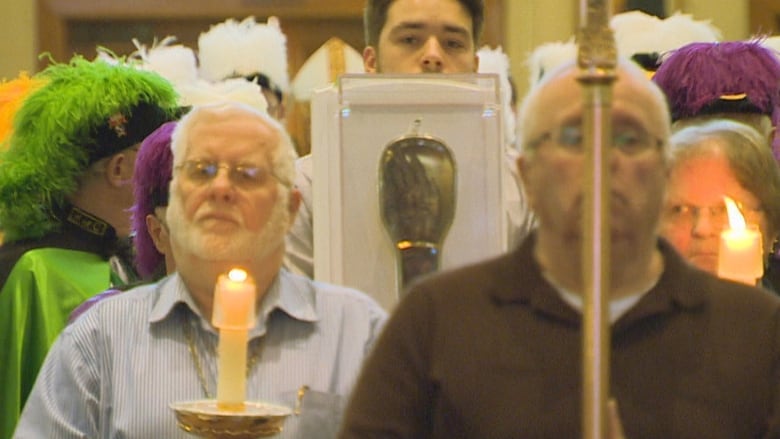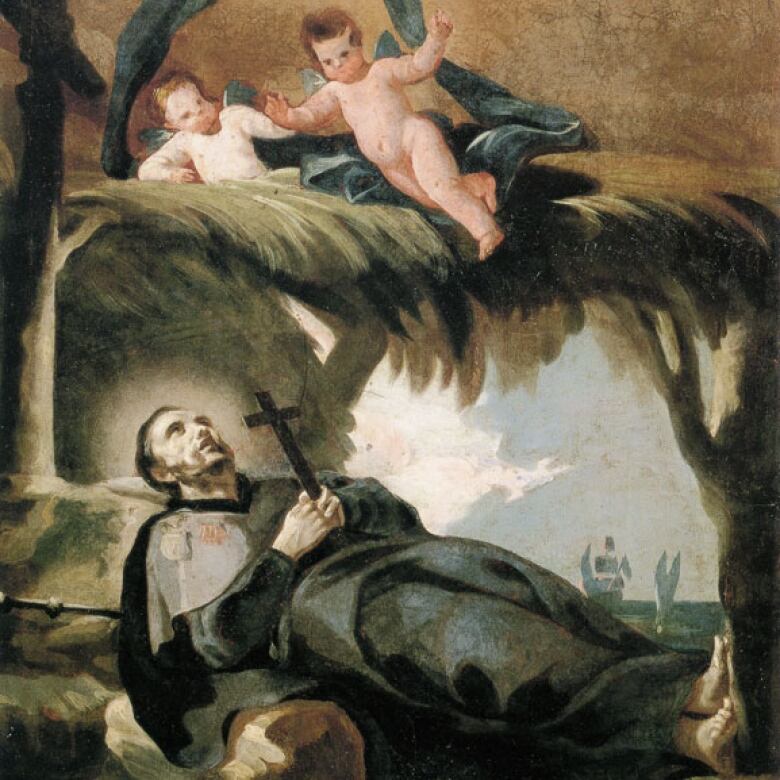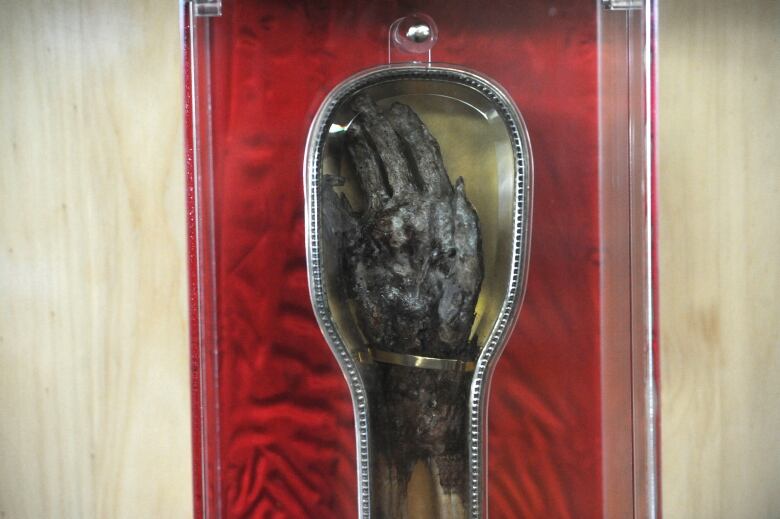Have arm, will travel: My encounter with a most unusual relic
When a part of St. Francis Xavier's arm came to St. John's, writer Wanita Bates found herself drawn in

It was not a typical round of"Friday Night Girls" for me. There was no mall, no chips and Coke, but there was a visit to see a 465-year-old arm at the Basilica of St. John the Baptist in St. John's.
This severed right forearm of Francis Xavier is now on its first visit to Canada, where it has been on display for visitors to venerate or honour. The tour finishes in early February.
The arm has also been flyingin its own airline seat, not because it has delusions of grandeur, but because of the case it sits in. It will not fit under the seat or in the overhead bin.
It sounds like travelling with the Stanley Cup, and we all know that hockey in Canada is like a religion. The reason his right arm is so revered has nothing to do with slap shotsbut is rather that during his life he'd blessed and baptized an estimated 100,000 converts.
Besides his arm being tired from all of that baptizing, St. Francis Xavier was a travelling man who spent a lot of time on his feet as he moved through France, Italy, Spain, Malaysia, Japan, Sri Lanka and India to spread the gospel.

He was trying to find a way into China when he died onDec.3, 1552, on the island of Sanchon(also known as Sancian).
His followers decided to bury Francis Xavier's body in a wooden casket. A grave was dug and the casket filled with lime so it would consume the flesh and make it easier to transfer his bones to India. Stones were put on the site of the grave to mark its location.
How a corpse became a relic
The grave was opened two and a half months after he was buried and the body was reportedly just as it had been at the time of death. The fact that the body did not decompose was considered evidence that Francis Xavier was indeed a saint, and his corpse became a relic.
When I say "relic," I don't mean the crotchety old man from The Beachcombers. I mean a Catholic Church relic. This is the physical remains or a personal effect related to the saint.

Being dead didn't stop Francis Xavier from getting around. In fact, St. Francis Xavier's toe made the list of Time magazine's Top 10 Famous Stolen Body Parts.
During the first exhibition of the corpse in 1554 in Goa, India, a Portuguese woman, Dona Isabel Carom, bit off a toe from the right foot to preserve it as a personal relic. (Which toe is in question, as I've read it was the big or the small toe.)
As the story goes, the toe gushed blood, and she was followed by thebloody tracks through Goa to her home. It must have been finders keepers, because that toe was not publicly exhibited by the family until 2009 in Lisbon.
One of his hands is in Japan and a diamond-encrusted fingernail sits on display in another village in Goa and in a church sits another toe on display.
A shoulder blade is on display in Macau and all the internal organs of the chest and abdomen were removed to various countries. The major portion of St. Francis Xavier's body rests in a crystal urn at a basilica at Old Goa.
A piece of the saint's bone is preserved in a small glass casket in a church outside Goa is at the St Francis Xavier Church inBhatpal. Bits of his bones were sent to churches that were built in his name.
Detaching an arm
In 1614, the entire right arm of the saint's body was detached and the upper arm was divided into two pieces both which were sent to two Jesuit colleges.
The hand and forearm were sent to Rome to the Church of the Ges, where it's been ever since.
You can count on one hand the number of times the arm has left on tour.

And now, this right arm, a relic from a saint, is about 50 people away from me.
There are also first-, second-, third- and fourth-class relics in the church.
The arm of St. Francis Xavier is considered a first-class relic. It is the body of a saint. A second-class relic is something the saint owned or frequently used, such as a rosary, book, crucifix or garment.
A third-class relic is an object that has touched a first- or second-class relic.
The first time I went to the Basilica, the lineup was so large, I did not have enough time to wait.
I did notice, though, that there were these lovely prayer cards they were passing out, so you could touch the front of Saint Francis Xavier's reliquary case and then have a third-class relic.
But on my second trip to the Basilica, around 9 p.m.there are no prayer cards to be seen. They'd run out of them.
My driver's licence will have to do
As I edgecloser to the front, I reach into my pocket. All I can feel is some used tissues and my wallet.
I look inside my wallet and see my debit and Visacard. No, not appropriate.
On my second trip to the Basilica, around 9 p.m.there are no prayer cards to be seen. They'd run out of them.
ASecond Cup gift card no.
Then I see my driver's licence, and I pull it out.
That's something I always carry with me, so I think this will make a fine third-class relic. I close in and move up to the arm. It is brownish and looks like an arm that has gone through the proverbial wringer. I rub my driver's licenceover the glass, and I cannot take my eyes off the relic.
I don't know about the power of relics but I do know this 465-year-old saint's arm has drawn a lot of people through its doors.
The faithful believe in the severed forearm of Saint Francis Xavier.
It's a tangible piece from a time long, long ago.

We all have kept a little something from people we loved who used to be in our lives.
Can it be any different than me with a small plastic pill bottle filled with my Grandmother Smith's gallstones?
She was like a saint to me, and that little bottle carries a memory.
It's something that connects you to the past, and that's always worth venerating.













_(720p).jpg)


 OFFICIAL HD MUSIC VIDEO.jpg)
.jpg)



























































































